Introduction to North East Dialects
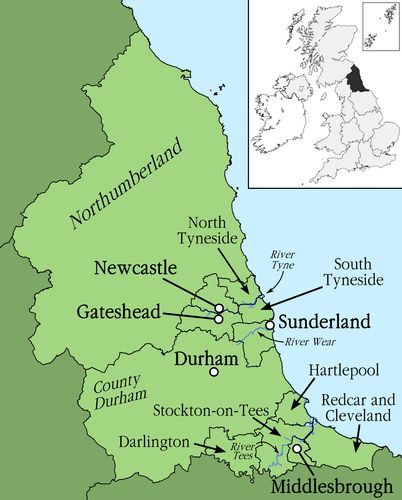
The North East region as defined within the Diachronic Electronic Corpus of Tyneside English project has its northernmost reaches at the Scottish-English border and continues from there to the southern banks of the river Tees in the south. Its westerly boundary is demarcated by the Pennine hills and the county boundaries of Northumberland and Durham with Cumbria. These hills, along with the three major rivers of the region, namely the Tyne, Wear and Tees, and the North Sea Coast, which forms its eastern boundary, are the principal geographical landmarks of the region. Its major urban centres include Newcastle/Gateshead, Sunderland and Middlesbrough and it is the most northerly region of England.
There is a general perception within the rest of the British Isles and further afield that the North East is synonymous with the 'Geordie' dialect and that the area exhibits a degree of homogeneity which is not matched on the ground. Research has shown not only that there are indeed quite distinctive regional varieties throughout the North East but that native speakers of these dialects are proud of their differences and that older people, in particular, are keen to maintain them.
These distinctions are borne out of ancient migratory movements across the region stretching back to Roman times when the term 'Britannia Inferior' was used to describe the North of England as far as Hadrian's Wall in contrast to 'Britannia Barbara' beyond it. Tyneside was the furthest point north within Britannia Inferior and Wallsend on the River Tyne's northern banks, as the name suggests, was its easternmost flank.
The post-Roman era witnessed a new wave of migration spearheaded by the Anglians originally from northern Germany and Denmark. It was they who established the region then known as Northumbria by uniting the north of Bernicia (north of the River Tees and including what would now be considered Scottish territory) and Deira (between the Tees and the Humber). The Anglo-Saxon records which remain from this period make it clear that the Northumbrian dialect of this language could readily be distinguished from the Saxon dominated varieties of southern and western England.

Bamburgh Castle. Bamburgh was the capital of the Anglo-Saxon
Kings of Northumbria.
The current castle was established by the Normans.
(Picture: Alex Brown
2009 CC BY)
The late Anglo-Saxon period was marked by the arrival of Scandinavian settlers, though these were concentrated in the area's southernmost reaches. This has important implications not only for the distribution of Norse derived place-names in the region but for helping establish the demarcation of the contemporary dialects of Tyneside, Wearside and Teesside which are locally recognised.
Further differentiation was facilitated by subsequent historical developments in these sub-districts of the North East like the concentration of coal extraction and export in Newcastle/Tyneside, the fact that Sunderland/Wearside boasted important salt and ship-building industries and the fact that Middlesbrough/Teesside was at one time the biggest global producer of pig-iron. The demise of these and other North East industries in the twentieth and twenty-first centuries has forced the areas to further diversify economically. Distinctive dialect zones have arisen on account of these different migratory patterns, as well as the variable historical and contemporary sources of income, although Newcastle remains the most culturally and economically dominant of the principle urban centres of the region.
These zones are marked by contrasts in identity, for example between the 'Geordies' from Newcastle and 'Mackems' from Sunderland, as well as at all levels of language. In this regard, the new book Urban North Eastern English (Beal, Burbano-Elizondo, Llamas 2012) notes that a well-known Geordie joke which plays on the fact that local Tyneside pronunciations of the words work and walk can be identical fails miserably in Middlesbrough, where the two words are generally differentiated. Similarly, while on Tyneside and Teesside the words make and take are pronounced with the same vowel that is heard in mate, for many Wearsiders they have the same vowel as mat, and therefore sound like 'Mac' and 'tack' respectively. Indeed, this is thought to be the accent feature from which their distinctive 'Mackem' label originates (Beal 1993).

The River Tyne
(Picture: Ian Britton
2008 CC BY-NC)
Urban North Eastern English also identifies grammatical differences across the North East, and links them to differences in the migratory history of the northern, central and southern zones of the region. Thus, Tyneside maintains its ancient links with the borders of Scotland in the fact that they both retain an older English feature not reported for Wearside or Teesside which allows sentences to contain more than one modal or auxiliary verb as in:
- (1) They might could be working in the shop.
[Miller (1993: 119) - Scottish English]
- (2) I can't play on Friday. I might could get it changed though.
[Beal (1993: 195) - Tyneside and Northumbrian English]
Likewise, the fact that Scandinavian settlement was more concentrated in the southern reaches of the North East may account for the fact that while Teesside speakers favour stereotypically Yorkshire features like a reduced pronunciation of the definite article the as t', this is unheard of in Tyneside where the Old Norse-speaking populations had less influence.
The same can be said of the impact that Scandinavian loan words have had on vocabulary within different sub-districts of the North East. The famous Survey of English Dialects conducted by scholars at the University of Leeds in the 1950s recorded Old Norse derived words like beck, meaning a 'stream or rivulet' in Durham and Teesside, which once belonged to Deira but not further north in rural Northumberland, the epicentre of Bernicia where the Anglian form burn was preferred. The same survey also found that the Old Norse word ket meaning 'rubbish' seemed to be restricted to areas in the central and southern zones of the North East. More recent studies in Wearside and Tyneside by Burbano-Elizondo (2001) and Simmelbauer (2000) find that it is current in both Sunderland and West Northumberland where it is used to mean 'sweets'. Neither study, however, reported this form with that particular meaning to be frequent in Tyneside.
What's in a name?
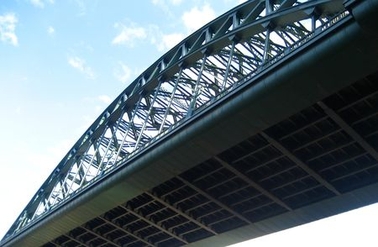
The Tyne Bridge
(Picture: Jeremy Keith
2011 CC BY)
Geordie. A diminutive of George. One possibility is that this name became associated with the people of Newcastle because, unlike others in the North East, they supported George I and then George II in the Jacobite Risings of 1715 and 1745. Another explanation is that George was a common and therefore stereotypical name among North East colliery workers, or a nickname they acquired specifically through their use of George Stephenson's safety-lamp, which then came to be applied generally to the people of Tyneside, as the focal point of the mining industry in the region.
Mackem or Makem. This is often linked to shipbuilding, with the phrase 'makem and takem' being seen for example as a reference to the disparaging idea that while workers in Sunderland would make ships, they would then need to be taken to Tyneside for the skilled tasks involved in fitting out and finishing them. Alternatively, it may have arisen simply as a characterization of the distinctive pronunciation of make that distinguishes Wearside from other parts of the North East.

The Wear Bridge
(Picture: Matt Wilson
2006 CC BY)
Pit-Yacker. A term that was applied to the people of the mining villages of Northumberland and Durham. The origin of yacker is obscure, with suggestions that it refers to a manual worker as someone who has to hack or thrash (yark). More tentative is the possibility that it is associated with yack meaning 'talk' or 'chatter', and therefore describes the jargon of the miners and by extension the dialect of their communities, which was also called pitmatic.
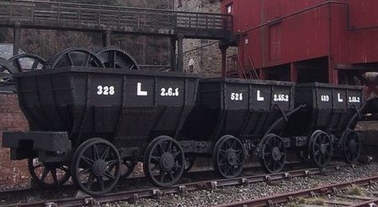
Colliery Wagons at Beamish Museum
(Picture: Sarah Charlesworth
2002 CC BY-SA)
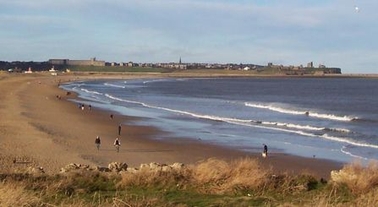
Sandhaven Beach, South Shields
(Picture: Michael Smith 2005 CC BY)
Sandancer or Sand-dancer. This name for the people of South Shields could be a straightforward reference to their position on the coast, at the mouth of the Tyne. Another suggestion, which is in keeping with the pejorative views that seem to be a common motivation in the initial development of these regional nicknames, is that it began as a comment on the relatively large number of people from Arabian and Asian countries who settled in the town as early as the beginning of the twentieth century.
Smoggie or Smoggy. This refers to people from Middlesbrough, and sometimes Teesside more generally. It is an allusion to the pollution that supposedly emanates from the area's industrial works, and especially the chemical plants that were established in the early twentieth century. As with some other regional nicknames (e.g. Mackem) it evidently became popular as a reference to local football supporters, and may even have been coined as an insult by rival supporters, before being adopted by the Middlesbrough fans themselves.
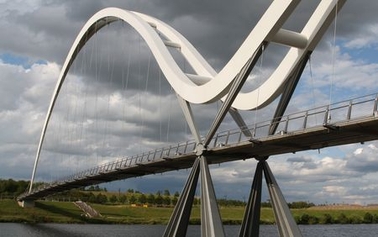
Infinity Bridge, Stockton
(Picture: Mrs Logic
2011 CC BY)
Bibliography
Beal, Joan C. (1993) 'The Grammar of Tyneside and Northumbrian English', in James Milroy and Lesley Milroy (eds.) Real English: the Grammar of English Dialects in the British Isles. London: Longman, 187-213.
Beal, Joan C., Lourdes Burbano-Elizondo and Carmen Llamas (2012) Urban North Eastern English. Edinburgh: Edinburgh University Press.
Burbano-Elizondo, Lourdes (2001) Lexical Erosion and Lexical Innovation in Tyne and Wear, M.Litt. dissertation, University of Newcastle upon Tyne.
Green, Adrian and A. J. Pollard (eds) (2007) Regional Identities in North-East England, 1300-2000. Wooldridge: Boydell.
Griffiths, Bill (2011) A Dictionary of North East Dialect, 3rd edition. Alnwick: Northumbria Press.
Jones, Mark (2002) 'The origin of Definite Article Reduction in northern English dialects: evidence from dialect allomorphy', English Language and Linguistics 6: 325-345.
Miller, J. (1993) 'The Grammar of Scottish English', in James Milroy and Lesley Milroy (eds.) Real English: the Grammar of English Dialects in the British Isles. London: Longman, 99-138.
Montgomery, Chris (2006) Northern English Dialects: a Perceptual Approach, PhD thesis, University of Sheffield.
Moody, Thomas (2007) The Mid-Northumbrian Dialect (edited by Joan C. Beal and Karen P. Corrigan). Morpeth: Northumbrian Language Society.
Orton, Harold and Eugen Dieth (1962-1971) Survey of English Dialects. Leeds: Arnold.
Orton, Harold, Stuart Sanderson and John D. A. Widdowson (1978) The Linguistic Atlas of England. London: Croom Helm.
Orton, Harold and Natalia Wright (1974) A Word Geography of England. London: Seminar Press.
Pearce, Michael (2009) 'A Perceptual Dialect Map of North East England', Journal of English Linguistics 37 (2): 162-192.
Simmelbauer, Andrea (2000) The Dialect of Northumberland. A Lexical Investigation. Heidelberg: Universitätsverlag C. Winter.
Simpson, David (1999) The Millennium History of North East England. Sunderland: Leighton / The Northern Echo.
Simpson, David (2002) Northern Roots. Sunderland: Business Education Publishers.
Wales, Katie (2006) Northern English. A Social and Cultural History. Cambridge: Cambridge University Press.
Picture Sources
Map: The map is based on two outline images:
UK & Ireland map -
'NordNordWest' (2011 CC BY-SA 3.0);
and North East England -
'Nilfanion' (2011 CC BY-SA 3.0).
Bamburgh Castle: Alex Brown (2009 CC BY).
River Tyne: Ian Britton (2008 CC BY-NC).
The Tyne Bridge: Jeremy Keith (2011 CC BY).
The Wear Bridge: Matt Wilson (2006 CC BY).
Beamish Colliery Wagons: Sarah Charlesworth (2002 CC BY-SA).
Sandhaven Beach, South Shields: Michael Smith (2005 CC BY).
The Infinity Bridge, Stockton: Mrs Logic (2011 CC BY 2.0).





